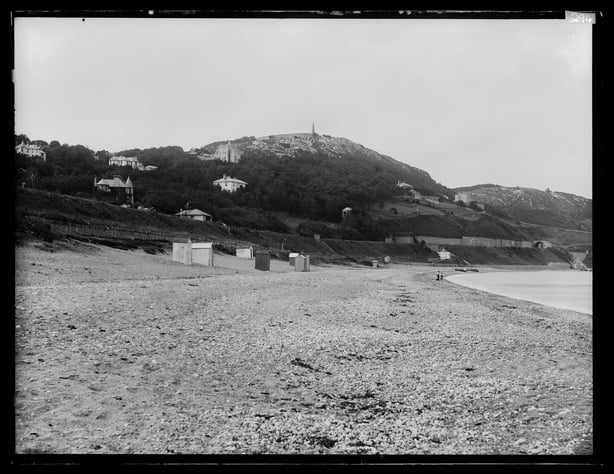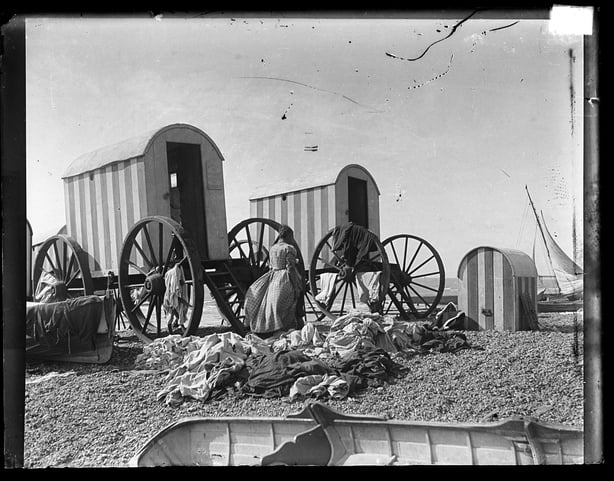Bathing dresses that fall to your ankle. A special machine to enter the water. This is Ruth Griffin's description of bathing in Dublin in the early 1900s.
While sea swimming is booming in the city over the last few years, thanks to a combination of easy access, a desire for wellness, and perhaps the Happy Pear twins' influence, Dublin's history of sea swimming has a legacy that runs deep.
Sea swimming first became fashionable in the early 18th century, not for pleasure but because it was recommended by the doctors to "bestow good health" and as a "cure-all" of the time.
And we're not stuck for swimming spots in Dublin. Think of the outdoor pools and swimming spots dotted across the city, from the Blackrock and Clontarf Baths, Sandymount to Seapoint and the Forty Foot in Sandycove. While the architecture and the locations are much the same, the way in which we spend time by the sea and what we wear has, understandably, greatly changed over the years.
The most obvious change is that the sexes are not separated anymore. From the beginning, swimming and seaside activities for men and for women were undertaken in very different ways.

Men vs women
When the craze began in the mid 18th century, gentlemen mainly bathed naked, usually in groups, while women took a dip fully clothed and in seclusion. Illustrations of women in the early 1800s show them wearing full-length bathing dresses which saved their modesty. As you can imagine, there aren't many illustrations of the men!
As historian Donal Fallon outlines on his podcast, Three Castles Burning, in an episode about the history of the Forty Foot, the separation of the sexes at this bathing spot was an ongoing battle right up to the 1970s. Seapoint and Sandymount became favourite paddling spots for women, and where the fashions began to change.
Slowly, swimming turned into a leisure activity with a beachside style to match, and soon Irish women's magazines began running features on style tips.
"The Forty Foot is for Women Too"
— RTÉ Archives (@RTEArchives) July 20, 2018
Women invade a swimming point traditionally for men only
WATCH: @RTENews reports #OnThisDay 1974 https://t.co/O0m38eoxXj
The 18th-century sea bathing outfit
While women now have the freedom to jump into the sea in anything from a bikini or a wetsuit, the 18th-century lady's entry into the sea was a little more elaborate.
All self-respecting women across the UK and Ireland at this time could only enter the sea via a bathing machine – a horse-drawn hut on wheels that drew you into the water so you could emerge and descend unseen into the water. These were a common sight on beaches across the UK and Ireland.
Even more elaborate were the bathing costumes at this time, which looked like you were fully dressed. The Victorian bathing suit was a dress layered over ankle-length bloomers, a style inspired by Amelia Bloomer – the American women's rights advocate who adopted the style of trousers early on –and popularised by the French.
These two garments were then topped off with a thigh-length jacket. They were usually made in dark flannels, serge and sometimes finished with embroidery. By our standards, it sounds like a cumbersome way to swim, but women of the time were so trussed up in corsets and layers that it must have felt like the ultimate liberation to submerge in the water in such loose clothing.

The popularity of paddling
In this way sea bathing became an elaborate and expensive habit for women: you had to hire the machine and very often the bathing suit if you wanted to be 'dipped' in the sea. But there were alternatives to getting your fix.
As the trip to the seaside became more democratised and not just for the wealthy, the popularity of paddling developed since you didn't need to remove your clothes in order to do it.
On a given trip to the seaside you might see girls wearing cotton blouses and straw hats, with A-line skirts perfectly suited for paddling and cycling, the two popular pastimes then.
The importance of the bathing cap
As swimming and sea dipping became an ever more popular activity, women had to manage not just their bathing look, but to take care of their skin and hair. Irish women’s magazine The Lady of the House (now Irish Tatler) in 1900 extolled the benefits of wearing a hat to protect hair, a trend which continues to today.
The writer says, "Delightful as it is, sea-bathing has a bad effect on the complexion and the hair. It makes the latter sticky and the former it discolours, except if one is careful to sponge the face with soft freshwater at once after returning home after one’s dip.
"I knew a pretty blond who always brought with her to the baths, a sponge soaked with fresh water, which she used the moment she came out of the sea. However, I think it is sufficient to take this precaution when one reaches the house. Sea water should not be allowed to remain in the hair either, but as most people wear bathing caps now-a-days one’s tresses seldom suffer."
Nude Bathing at the Forty Foot #OnThisDay 30 years ago
— RTÉ Archives (@RTEArchives) July 17, 2019
Traditionally the sanctuary of male nude bathers, the Forty Foot saw women show out to protest at their exclusion from the bathing zone.
WATCH: @RTENews reports #OnThisDay in 1989 https://t.co/TRhbXyZ1LX pic.twitter.com/uJoQIyo3NY
Swimsuits go streamlined
Although Coco Chanel is often credited with popularising the suntan, having a bronzed glow was also buoyed by a post-war generation who enjoyed their newfound liberation through activities like swimming.
A great pair of beach pyjamas and a streamlined swimsuit was just the ticket to do hit the beach with aplomb. Avril Lansdell in her book Seaside Fashions, says that 1920s bathing costumes for men and for women started to be made closer to the body and without sleeves at this time with styles usually ranging from black, navy, maroon or royal blue.
The focus was for the costume to stay close to the body, so you could move and be active. The revolutionary material that helped this at the time was machine knitted wool or cotton stockingette.
While Dublin was not the French Riviera, the seaside towns on the bay was still a popular spot for day-trippers and holidaymakers.
In the 1920s, there was a women's and children's pool in Dun Laoighaire, Co Dublin, where, again, there was a segregation of the sexes - this area of the baths was a specific place to swim for women only.
At this time, you would have seen knitted, sleeveless bathing suits that come to mid-thigh and the popular rubberised bathing caps, which were usually white and fastened under the chin and other mob-cap style caps, (a bit like a shower cap) can be seen here too, designed to protect their bobbed hair.

Lying by the Lido
By the 1930s the vogue for swimming continued and so too did the style of the bathing suit. The look now was much more svelte and fashion-forward than the 1920s, helped no doubt by the growing availability of Hollywood movies and fashion magazines.
Swimsuit styles were still mainly one-pieces and had lower cutbacks than fronts, and there were often styles with risque cut-out details as well as additions of contrasting belts, patterns and colour.
In Dun Laoighaire the baths had been developed into a Lido at this time, explains Candace White of the website Nova, Vintage Treasure. She says "In images from the 1930s, the façade facing the sea [of the Dun Laoighaire baths] looks like typical 'lido’ architecture. A smooth pale stuccoed concrete surface and stark rectilinear openings correspond with the engineer-style of the era."
It is in a location like this that you can imagine our Modern Girl from the magazine pictured, lounging in her newly crocheted beach ensemble and waved hair. The magazine not only gives the look for the Lido but more tips to bathers on how to Swim for Pleasure, saying, "Don’t over do [swimming] and don’t make a spartan rite out of it.
"Unless you are very strong and very accustomed to the water, cut out an early morning bathe so beloved by writers of holiday storyettes. The time to bathe, for the average person, is when the sun is high and shining and you can have a sun-bath afterward. And don’t stay in too long. Twenty minutes is the absolute maximum for ordinary folk."
We need your consent to load this rte-player contentWe use rte-player to manage extra content that can set cookies on your device and collect data about your activity. Please review their details and accept them to load the content.Manage Preferences
From RTÉ Archives, Dubliners at the seaside location of Seapoint in 1962
Swimming and style in the 21st century
The history of Dublin's swimming spots has changed with the ebb and flow of both fashion and architecture in the city. In the 21st century, swimming and promenading beside the sea, on a pier or down a beach continues to be an activity enjoyed in Dublin.
As foreign sun holidays became more popular in the late 20th century this had an effect on the number of people enjoying the Dublin seaside with many activities falling out of fashion, but what’s interesting today is we are now seeing resurgence of interest as sea swimming from these historic spots, it has now become the ultimate Instagram moment to take a dip for your health, The Happy Pear’s Swimrise in Greystones being a great example.
The Dun Laoighaire and Clontarf Baths are also being renovated as restaurants and artist studios as well as record numbers of people enjoying the Forty Foot with each coming year. With typical fashion items of the 21st century now being sported at our hot spots being the Dry Robe, wet suit and an iPhone, ready to Instagram your dip for posterity.
- Written by Ruth Griffin
About Ruth Griffin
Ruth Griffin is a fashion historian and writer with a background in fashion design from the National College of Art & Design in Dublin and a Master’s degree in History & Culture of Fashion from London College of Fashion. Over the last 15 years, she has developed her knowledge and her expertise of Irish fashion history via walks, talks and tours around Dublin.

